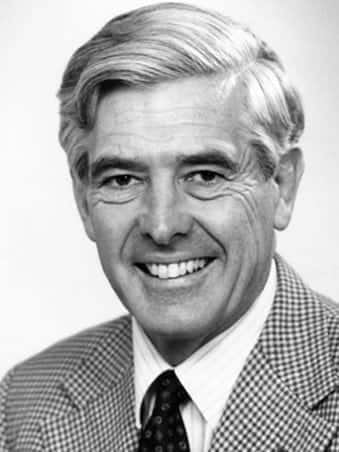Michael Denborough

Michael Antony Denborough (1929–2014) was an Australian anaesthetist, academic, politician and medical researcher.
Denborough was an Australian physician–scientist whose name is inseparable from the discovery and early delineation of malignant hyperthermia (MH). Trained in Cape Town and Oxford (Rhodes Scholar; DPhil, 1956), he moved to Melbourne in 1960 and was asked to investigate a family with multiple anaesthetic deaths. His 1960 Lancet letter introduced the term “malignant hyperpyrexia” as a distinct peri-anaesthetic crisis. He went on to establish the conditions familial nature and a genetic model for anaesthetic susceptibility at a time when most peri-operative catastrophes were viewed as idiosyncratic.
Over subsequent decades Denborough helped define the clinical and genetic spectrum of MH and related myopathies, culminating in the description of King–Denborough syndrome (1973). Working across anaesthesia, neurology, and muscle physiology, he championed family tracing, pre-operative risk identification, and the development of provocation/contracture testing that underpinned later guidelines. His leadership roles and engagement with emerging MH groups shaped international networks that ultimately integrated laboratory genetics (e.g., RYR1/CACNA1S) with bedside practice and the dantrolene treatment era.
Denborough’s public life extended beyond the laboratory. He became a prominent anti-nuclear activist and founding member of Australia’s Nuclear Disarmament Party, arguing for medical responsibility in matters of war and environmental risk. Honoured with national and professional awards, he remained an advocate for science-driven patient safety. Denborough’s legacy is twofold: the prevention of avoidable deaths through recognition of MH as a heritable disorder, and a model of physician-citizenship that linked clinical discovery to broader public ethics.
Biographical Timeline
- Born on July 11, 1929 in Salisbury, Rhodesia (now Harare, Zimbabwe)
- 1952 – MB ChB (Medicine) University of Cape Town; awarded Rhodes Scholarship (1953) to Oxford (Exeter College); DPhil (1956)
- 1958 – Resident Medical Officer, National Heart Hospital, London.
- 1960 – Moves to Melbourne, Australia. First Assistant (research fellow) at University of Melbourne / Royal Melbourne Hospital. Asked to investigate a family with multiple anaesthetic deaths. Coins the term malignant hyperpyrexia (later malignant hyperthermia (MH)) in a Lancet letter.
- 1962 – Follow-up paper “Anaesthetic deaths in a family” establishes MH as a familial condition.
- 1970–1973 – Extends MH research to associated myopathies and J.O. King describes King–Denborough syndrome (1973).
- 1972 – Eric Susman Prize, Royal Australasian College of Physicians.
- 1974–1991 – Professorial Fellow, John Curtin School of Medical Research (JCSMR), Canberra. Broadens work to muscle disorders linked to MH.
- 1982 – Gold Medal, Fifth International Congress on Neuromuscular Diseases (Marseilles).
- 1984 – Founding figure of the Nuclear Disarmament Party (NDP) with sustained public anti-nuclear advocacy.
- 1992–1994 – Professor, JCSMR, Australian National University; Emeritus from 1995.
- 1995 – Retired to a role of Emeritus Professor
- 1999 – Appointed Member of the Order of Australia (AM) for services to medicine.
- 2003 – 52-day solo vigil outside Parliament House, Canberra opposing the Iraq invasion; ejected from Parliament after protest.
- Died on February 8, 2014 in Melbourne, Australia
Medical Eponyms
Maladie de Denborough (1960) (malignant hyperthermia)
Malignant hyperthermia (MH) is a pharmacogenetic disorder of skeletal muscle precipitated by volatile anaesthetics and/or succinylcholine. Pathogenesis centres on dysregulated sarcoplasmic-reticulum calcium release, most often RYR1 (and less commonly CACNA1S) variants. This results in a hypermetabolic crisis with rapid rise in end-tidal CO₂, tachycardia, muscle rigidity, acidosis, hyperkalaemia, and later marked hyperthermia with rhabdomyolysis.
Diagnosis rests on in-vitro contracture testing (caffeine–halothane/IVCT) and/or molecular testing in kindreds. Immediate management is trigger cessation, high-flow O₂, aggressive supportive care, and dantrolene, which has reduced mortality from historically high levels to single-digit percentages in well-prepared centres. Family counselling, alert bracelets, and MH-safe anaesthesia are key to prevention.
1960 – At the Royal Melbourne Hospital, anaesthetist Jim Villiers attended a 21-year-old engineering student with a compound right tibia fracture requiring general anaesthesia for ORIF. The patient was terrified as 10 of his family members had died during following general anaesthesia. Villiers decided to administer halothane and the fracture was promptly reduced and closed. However the patient developed tachycardia, hypotension, hypoxaemia and hyperthermia. Villiers packed him in ice and he was resuscitated successfully.
Michael Denborough and his colleague Richard Lovell then went on to study this patients family in greater detail. They outlined the autosomal dominant inheritance of this severe reaction to anaesthetics in The Lancet.
We have been asked to investigate a man aged 21… several close relatives had died during or shortly after anaesthesia… Ten minutes after the operation began… the pulse rose… His skin now felt very hot… he sweated profusely and complained of feeling burning hot… Inquiry shows that of the 24 relatives… 10 have died
Denborough 1960
1962 – Denborough published “Anaesthetic deaths in a family” which established MH as a familial condition, shifting thinking from idiosyncratic mishap to inherited risk. The research team recommended family tracing and peri-operative precautions.
The susceptibility to develop malignant hyperpyrexia is due to a genetic anomaly… most cases occur in individuals with a myopathy which is inherited as a dominant characteristic
Denborough et al, 1962
1960s – Early MH mortality was high because diagnosis was delayed and no specific treatment existed. Denborough’s familial model enabled pre-op risk identification, while laboratory teams built provocation tests that became the diagnostic standard.
1967 – Snyder et al. report a new hydantoin muscle-relaxant class (dantrolene sodium) with direct skeletal-muscle action (not via NMJ or CNS). This provides, for the first time, a plausible pharmacologic countermeasure to the runaway muscle metabolism seen in MH.
Early 1970s – Experimental physiology shows dantrolene reduces sarcoplasmic-reticulum Ca²⁺ release and blunts contracture responses in isolated muscle. Conceptually, this maps onto the MH crisis (Ca²⁺-driven hypermetabolism). Development of in-vitro contracture testing (IVCT/CHCT; caffeine–halothane test) on fresh muscle biopsy to classify MH susceptible (MHS) vs MH negative.
1975 — Harrison demonstrates that in susceptible swine, IV dantrolene prevents and terminates halothane/sux-triggered crises. This is the translational hinge: from pharmacology to a treatment that works in a whole-animal model of MH.
1977 – Austin and Denborough publish an early treatment review, concluding that among proposed agents, dantrolene is the most effective for reversing the MH physiology and recommend its availability in operating rooms.
Of the various drugs… dantrolene sodium was the most effective in reversing and inhibiting drug-induced contractures… It is suggested that dantrolene sodium is the drug of choice for lowering the raised myoplasmic calcium concentrations in malignant hyperpyrexia
Austin, Denborough 1977
1979 — First documented human rescue. Case report to describe successful termination of fulminant MH with IV dantrolene during anaesthesia, catalysing rapid clinical adoption and protocol writing.
1981 – MHAUS founded, accelerating guidelines, mandated dantrolene access in operating suites, simulation training, and MH hotline/registries. Mortality falls from historical levels to single digits in prepared centres.
Today: Dual pathway diagnosis—IVCT (physiology) and molecular testing (e.g., RYR1, CACNA1S)—with perioperative electronic alerts, family counselling, and MH-safe anaesthetic protocols.
King–Denborough Syndrome (1973)
King-Denborough syndrome (KDS) is an autosomal dominant disorder characterized by the triad of congenital myopathy, dysmorphic features, and susceptibility to malignant hyperthermia. Caused by heterozygous mutation in the RYR1 gene
1973 – First described by John Owen King and Denborough who reported children with dysmorphic facies and hypotonia who developed malignant hyperpyrexia under anaesthesia, linking a recognizable phenotype to inherited MH risk. Core features include
- Mild congenital myopathy (axial > limb), hypotonia, delayed motor milestones
- Facial features: ptosis, high-arched palate, micro/retrognathia; sometimes low-set ears
- Skeletal: pectus deformity, scoliosis, joint laxity; occasionally short stature
Malignant hyperpyrexia is an often fatal complication of anesthesia occurring in individuals with underlying muscle disease. One clinical myopathy occurs in young boys who are small for age… with cryptorchidism, kyphosis, lordosis, and pectus carinatum and an unusual facial appearance with a small chin, low-set ears…
King, Denborough 1973
Significant anaesthetic risk with volatile agents and suxamethonium. Managed by using MH-safe anaesthesia, perioperative planning with family cascade testing (genetic ± IVCT), long-term physio/orthopaedic support.
Major Publications
- Denborough MA, Levell RRH. Anaesthetic deaths in a family. Lancet 1960; 276(7140): 45
- Denborough MA, Forster JF, Lovell RR, Maplestone PA, Villiers JD. Anaesthetic deaths in a family. Br J Anaesth. 1962 Jun;34:395-6.
- Denborough MA, Ebeling P, King JO, Zapf P. Myopathy and malignant hyperpyrexia. Lancet. 1970; 295(7657): 1138-1140
- King JO, Denborough MA, Zapf PW. Inheritance of malignant hyperpyrexia. Lancet. 1972; 1(7746): 365-70.
- King JO, Denborough MA. Anesthetic-induced malignant hyperpyrexia in children. J Pediatr. 1973; 83(1): 37-40. [King–Denborough Syndrome]
- Moulds RF, Denborough MA. Biochemical basis of malignant hyperpyrexia. Br Med J. 1974; 2(5913): 241-4.
- Austin KL, Denborough MA. Drug treatment of malignant hyperpyrexia. Anaesth Intensive Care. 1977 Aug;5(3):207-13. [Dantrolene]
- Denborough MA. Malignant hyperpyrexia. Med J Aust. 1977 Dec 3;2(23):757-8.
- Denborough MA, Galloway GJ, Hopkinson KC. Malignant hyperpyrexia and sudden infant death. Lancet. 1982; 320(8307): 1068-9.
- Denborough MA, Collins SP, Hopkinson KC. Rhabdomyolysis and malignant hyperpyrexia. Br Med J (Clin Res Ed). 1984 Jun 23;288(6434):1878.
- Denborough MA. Malignant hyperthermia. 1962. Anesthesiology. 2008 Jan;108(1):156-7.
- Denborough MA. Malignant hyperthermia. Lancet. 1998; 352(9134): 1131-1136
Controversies
Radioiodine findings & French nuclear tests (early 1970s):
While in Melbourne, Denborough monitored radioactive iodine (I-131) uptake in sheep thyroids and noted rises coincident with French atmospheric tests in the Pacific. When he felt government response was insufficient, he and colleague Roger Melick issued a press statement that drew national attention. The issue was subsequently taken up by the Whitlam Government (elected Dec 1972), whose Attorney-General Lionel Murphy initiated proceedings against France in the International Court of Justice (1973) alongside New Zealand. Atmospheric testing ceased after 1974, with France moving to underground tests from 1975.
Civil disobedience & arrests (1991, mid-1990s):
Denborough’s anti-nuclear activism continued for decades. He was arrested at AIDEX (Canberra, 1991) during protests against an arms exposition, and again outside the French Embassy (1995) after France resumed nuclear testing in the Pacific. He framed these protests as matters of medical ethics and public health.
Iraq War protest (2003):
Following the decision of the Howard Government to commit Australian forces to Iraq, Denborough staged a solo 52-day vigil outside Parliament House, Canberra. He was ejected from the parliamentary gallery after a vocal protest on the day troop commitment was announced.
References
Biography
- Maltby R. Notable Names in Anaesthesia. The Choir Press 2013: 46-48
- Remembering Malignant Hyperthermia Pioneer: Michael Denborough, MD. NewsWire 2014
- Denborough L. Obituary: Michael Denborough. The Greens. 2014 June
- Gillies R. Michael Antony Denborough. RCP Inspiring Physicians
Eponymous terms
- Snyder HR Jr, Davis CS, Bickerton RK, Halliday RP. 1-[(5-arylfurfurylidene)amino]hydantoins. A new class of muscle relaxants. J Med Chem. 1967 Sep;10(5):807-10. [Dantrolene]
- Harrison GG. Control of the malignant hyperpyrexic syndrome in MHS swine by dantrolene sodium. Br J Anaesth. 1975 Jan;47(1):62-5.
- Friesen CM, Brodsky JB, Dillingham MF. Successful use of dantrolene sodium in human malignant hyperthermia syndrome: a case report. Can Anaesth Soc J. 1979 Jul;26(4):319-21.
- Reed UC et al. King-Denborough Syndrome: report of two Brazilian cases. Arq Neuropsiquiatr. 2002 Sep;60(3-B):739-41.
- Kaur H, Katyal N, Yelam A, Kumar K, Srivastava H, Govindarajan R. Malignant Hyperthermia. Mo Med. 2019 Mar-Apr;116(2):154-159.
Eponym
the person behind the name
Clinical Geneticist
BSc(Med) MBBS MMed FRACP | Genetics Online |
MD, Bond University. Currently Intensive Cares Registrar at SJOG Midland. Pianist and avid Golfer | LinkedIn |

